

Since the oil’s viscosity will change with temperature, most OEMs will supply a temperature–viscosity chart for their equipment to help ensure the correct viscosity is used depending on the operating temperature. In this case, the internal molecules gain more energy with the increase in temperature, lowering the internal friction within the fluid. Its viscosity will decrease, and the ice will turn to water. This is similar to a block of ice melting as temperatures increase. Likewise, as the oil heats up, it can become thinner.

This means the oil will get thicker or more resistant to flow at lower temperatures. Similarly, for lubricants, as the temperature drops, the viscosity increases. Its viscosity can change depending on the influencing factors.Īs seen with the example of the water above, when the temperature decreases, the water can turn to ice. If water is at its freezing point (0☌), it can turn to ice but remains liquid at room temperature (around 20-30☌). For instance, water can assume other states depending on the temperature. Similar to the molasses and water examples above, different factors can affect the viscosity of a liquid. It will flow much faster than molasses (straight 50) with the same straw! The lighter-weight oil would also transfer heat and flow much faster than the heavier-weight (more viscous) oil. However, if a lighter weight (or less viscous) engine oil was used (such as a 0w20 or 10w30), then this is like someone trying to drink water (0w20) with a smaller straw. This would be equivalent to the user using a smaller straw for drinking molasses.

The clearances also got smaller, and the engine oil was now required to flow faster, control the transfer of heat and contaminants and keep the engine lubricated.Ī straight 50 oil could not pass through the smaller straw at the speed it should. As such, most of these engines used a 50-weight (or straight 50) oil.Īs the technology evolved, the size of the engines got smaller. These engines had larger clearances for the oil to flow throughout the engine. We can draw this analogy to car engines over the last 30-40 years. However, getting the same liquid to the person using the straw would take longer if a thinner straw were used. Pulling the liquid from the cup will be easy using a big straw. You can also apply this to using a straw for drinking water from a glass.


 0 kommentar(er)
0 kommentar(er)
